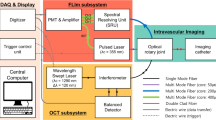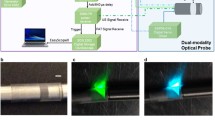Abstract
The objective of this study is to characterize arterial tissue with and without atherosclerosis by fluorescence lifetime imaging microscopy (FLIM) using Europium Chlortetracycline complex (EuCTc) as fluorescent marker. For this study, twelve rabbits were randomly divided into a control group (CG) and an experimental group (EG), where they were fed a normal and hypercholesterolemic diet, respectively, and were treated for 60 days. Cryosections of the aortic arch specimens were cut in a vertical plane, mounted on glass slides, and stained with Europium (Eu), Chlortetracycline (CTc), Europium Chlortetracycline (EuCTc), and Europium Chlortetracycline Magnesium (EuCTcMg) solutions. FLIM images were obtained with excitation at 405 nm. The average autofluorescence lifetime within plaque depositions was ~1.36 ns. Reduced plaque autofluorescence lifetimes of 0.23 and 0.31 ns were observed on incubation with EuCTc and EuCTcMg respectively. It was observed a quenching of collagen, cholesterol and TG emission spectra increasing EuCTc concentration. The drastic reduction in fluorescence lifetimes is due to a resonant energy transfer between collagen, triglycerides, cholesterol and europium complexes, quenching fluorescence.




Similar content being viewed by others
References
Castelli WP (1996) Lipids, risk factors and ischaemic heart disease. Atherosclerosis 124:S1–S9
Ross R (1999) Mechanisms of disease–Atherosclerosis––an inflammatory disease. N Engl J Med 340:115–126
Ross JS, Stagliano NE, Donovan MJ, Breitbart RE, Ginsburg GS (2001) Atherosclerosis and cancer––common molecular pathways of disease development and progression. Ann N Y Acad Sci 947:271–293
Mahia-Casado P, Garcia-Orta R, Gomez de Diego JJ, Barba-Cosials J, Rodriguez-Palomares JF, Aguade-Bruix S (2015) Update on Cardiac Imaging Techniques 2014. Revista Espanola De Cardiologia 68:129–135
Aghayev A, Murphy DJ, Keraliya AR, Steigner ML (2016) Recent developments in the use of computed tomography scanners in coronary artery imaging. Expert Rev Med Devices 13:545–553
Vijayalaxmi M, Fatahi OS (2015) Magnetic resonance imaging (MRI): a review of genetic damage investigations. Mutat Res Rev Mutat Res 764:51–63
Sarikaya I (2015) Cardiac applications of PET. Nucl Med Commun 36:971–985
Escolar E, Weigold G, Fuisz A, Weissman NJ (2006) New imaging techniques for diagnosing coronary artery disease. Can Med Assoc J 174:487–495
Blankstein R (2012) Cardiology patient page. Introduction to noninvasive cardiac imaging. Circulation 125:e267
Dunn JP, Huizinga MM, See R, Irani WN (2010) Choice of imaging modality in the assessment of coronary artery disease risk in extreme obesity. Obesity 18:1–6
Maarek JMI, Marcu L, Fishbein MC, Grundfest WS (2000) Time-resolved fluorescence of human aortic wall: use for improved identification of atherosclerotic lesions. Lasers Surg Med 27:241–254
Manolopoulos A, Vasileiou A, Kokkinos V, Athanasopoulos C, Agapitos E, Kavantzas N, Yova D (2000) Comparative studies of Laser Induced Fluorescence and Intravascular Ultrasound for the human coronary artery diagnosis of atherosclerosis. Optics and lasers in biomedicine and culture. Series of the international society on optics within life sciences. Vol 5, pp 316–323
Megens RTA, Bianchini M, Schmitt MMN, Weber C (2015) Optical imaging innovations for atherosclerosis research multiphoton microscopy and optical nanoscopy. Arterioscler Thromb Vasc Biol. 35:1339–1346
Sanz J, Fayad ZA (2008) Imaging of atherosclerotic cardiovascular disease. Nature 451:953–957
Sicchieri LB, Barioni MB, Silva MN, Monteiro AM, Figueiredo Neto AM, Ito AS, Courrol LC (2014) Atherosclerosis staging: imaging using FLIM technique. In: Proceedings SPIE 8947, imaging, manipulation, and analysis of biomolecules, cells, and tissues XII, 89472B (March 4, 2014). doi:10.1117/12.2040139
Arakawa K, Isoda K, Ito T, Nakajima K, Shibuya T, Ohsuzu F (2002) Fluorescence analysis of biochemical constituents identifies atherosclerotic plaque with a thin fibrous cap. Arterioscler Thromb Vasc Biol 22:1002–1007
Bartorelli AL, Leon MB, Almagor Y, Prevosti LG, Swain JA, McIntosh CL, Neville RF, House MD, Bonner RF (1991) Invivo human atherosclerotic plaque recognition by laser-excited fluorescence spectroscopy. J Am Coll Cardiol 17:B160–B168
Morguet AJ, Korber B, Abel B, Hippler H, Wiegand V, Kreuzer H (1994) Autofluorescence spectroscopy using a xecl excimer-laser system for simultaneous plaque ablation and fluorescence excitation. Lasers Surg Med 14:238–248
Sun Y, Sun Y, Stephens D, Xie H, Phipps J, Saroufeem R, Southard J, Elson DS, Marcu L (2011) Dynamic tissue analysis using time-and wavelength-resolved fluorescence spectroscopy for atherosclerosis diagnosis. Opt Express 19:3890–3901
Jo JA, Fang Q, Papaioannou T, Baker JD, Dorafshar AH, Reil T, Qiao JH, Fishbein MC, Freischlag JA, Marcu L (2006) Laguerre-based method for analysis of time-resolved fluorescence data: application to in-vivo characterization and diagnosis of atherosclerotic lesions. J Biomed Opt 11(2):021004. doi:10.1117/1.2186045
Marcu L, Fishbein MC, Maarek JMI, Grundfest WS (2001) Discrimination of human coronary artery atherosclerotic lipid-rich lesions by time-resolved laser-induced fluorescence spectroscopy. Arterioscler Thromb Vasc Biol 21:1244–1250
Anderssonengels S, Johansson J, Svanberg K, Svanberg S (1991) Fluorescence imaging and point measurements of tissue––applications to the demarcation of malignant-tumors and atherosclerotic lesions from normal tissue. Photochem Photobiol 53:807–814
Phipps J, Sun Y, Saroufeem R, Hatami N, Fishbein MC, Marcu L (2011) Fluorescence lifetime imaging for the characterization of the biochemical composition of atherosclerotic plaques. J Biomed Opt 16:096018
Marcu L, Fang QY, Jo JA, Papaioannou T, Dorafshar A, Reil T, Qiao JH, Baker JD, Freischlag JA, Fishbein MC (2005) In vivo detection of macrophages in a rabbit atherosclerotic model by time-resolved laser-induced fluorescence spectroscopy. Atherosclerosis 181:295–303
Phipps J, Sun Y, Saroufeem R, Hatami N, Marcu L (2009) Fluorescence lifetime imaging microscopy for the characterization of atherosclerotic plaques. In: Kollias N, Choi B, Zeng H, Malek RS, Wong BJF, Ilgner JFR, Gregory KW, Tearney GJ, Marcu L, Hirschberg H, Madsen SJ (eds) Proceedings SPIE 7161, photonic therapeutics and diagnostics V, 71612G (February 23, 2009). doi:10.1117/12.813087
Ashjian P, Elbarbary A, Zuk P, DeUgarte DA, Benhaim P, Marcu L, Hedrick MH (2004) Noninvasive in situ evaluation of osteogenic differentiation by time-resolved laser-induced fluorescence spectroscopy. Tissue Eng 10:411–420
Lindgren I, Raekalli J (1966) Accumulation of tetracyclines in atherosclerotic lesions of human aorta. Acta Pathol Microbiol Scand 66:323–326
Golub LM, Greenwald RA (2011) Clinical applications of non-antibacterial tetracyclines. Part II preface. Pharmacol Res 64:549–550
Donohue J, Trueblood KN, Webster MS, Dunitz JD (1963) Crystal structure of aureomycin (chlortetracycline) hydrochloride––configuration, bond distances and conformation. J Am Chem Soc 85:851
Welch H (1953) About the chemically descriptive generic terms for aureomycin (chlortetracycline) and terramycin (oxytetracycline). Antibiot Chemother 3:659–662
Durckheimer W (1975) Tetracyclines—chemistry, biochemistry, and structure–activity relations. Angew Chem Int Ed Engl 14:721–734
Benet LZ, Goyan JE (1966) Thermodynamics of chelation by tetracyclines. J Pharm Sci 55:1184–1190
Coibion C, Laszlo P (1979) Binding of the alkali-metal cations to tetracycline. Biochem Pharmacol 28:1367–1372
Courrol LC, Silva FRD, Gomes L, Vieira ND (2007) Energy transfer study of europium-tetracycline complexes. J Lumin 122:288–290
Courrol LC, Samad RE (2008) Applications of europium tetracycline complex: a review. Curr Pharm Anal 4:238–248
Georges J, Ghazarian S (1993) Study of europium-sensitized fluorescence of tetracycline in a micellar solution of triton x-100 by fluorescence and thermal lens spectrometry. Anal Chim Acta 276:401–409
Hirschy LM, Vangeel TF, Winefordner JD, Kelly RN, Schulman SG (1984) Characteristics of the binding of europium(iii) to tetracycline. Anal Chim Acta 166:207–219
Izquierdo P, Gomezhens A, Perezbendito D (1994) Study of the Eu(iii)-tetracycline-thenoyltrifluoroacetone system by using the stopped-flow mixing technique––determination of tetracycline in serum. Anal Chim Acta 292:133–139
Courrol LC, Sicchieri LB, Silva DC (2013) Cholesterol accumulation in the cornea and in the aorta: imaging using europium chlortetracycline complex fluorescent probe. In: Conference on optical diagnostics and sensing XIII-toward point-of-care diagnostics, San Francisco, CA
Teixeira LDS, Grasso AN, Monteiro AM, Figueiredo Neto AM, Vieira ND Jr, Gidlund M, Courrol LC (2010) Enhancement on the Europium emission band of Europium chlortetracycline complex in the presence of LDL. Anal Biochem 400:19–24
da Silva MN, Sicchieri LB, de Oliveira Silva FR, Andrade MF, Courrol LC (2014) Liquid biopsy of atherosclerosis using protoporphyrin IX as a biomarker. Analyst 139:1383–1388
Keijzer M, Richardskortum RR, Jacques SL, Feld MS (1989) Fluorescence spectroscopy of turbid media––autofluorescence of the human aorta. Appl Opt 28:4286–4292
Murata K, Motayama T, Kotake C (1986) Collagen types in various layers of the human aorta and their changes with the atherosclerotic process. Atherosclerosis 60:251–262
Dos Santos I, Mazeres S, Freche M, Lacout J-L, Sautereau A-M (2008) FRET: a tool to study the interaction between apatite and collagen? Mater Lett 62:4377–4379
Chou KF, Dennis AM (2015) Forster resonance energy transfer between quantum dot donors and quantum dot acceptors. Sensors 15:13288–13325
Hiltunen TP, Luoma JS, Nikkari T, Yla-Herttuala S (1998) Expression of LDL receptor, VLDL receptor, LDL receptor-related protein, and scavenger receptor in rabbit atherosclerotic lesions––marked induction of scavenger receptor and VLDL receptor expression during lesion development. Circulation 97:1079–1086
Matthaus C, Cicchi R, Meyer T, Lattermann A, Schmitt M, B.F.M. Romeike, Krafft C, Dietzek B, Brehm BR, Pavone FS, Popp J (2014) Multimodal nonlinear imaging of atherosclerotic plaques differentiation of triglyceride and cholesterol deposits. J Innov Opt Health Sci 7:10
San Antonio JD, Di Lullo GA, Sweeney SM, Korkko J, Ala-Kokko L (2001) Mapping the ligand-binding sites and disease-associated mutations on the most abundant protein in the human-type I collagen Mol Biol Cell 12:9A–9A
Caminati G, Focardi C, Gabrielli G, Gambinossi F, Mecheri B, Nocentini M, Puggelli M (2002) Spectroscopic investigation of tetracycline interaction with phospholipid Langmuir–Blodgett films. Mat Sci Eng C-Biomim Supramol Sys 22:301–305
Acknowledgments
The authors acknowledge the National Institute of Science and Technology on Photonics Applied to Cell Biology (INFABIC) at the State University of Campinas for granting access to equipment and for providing assistance in this study. INFABIC is co-funded by Fundação de Amparo a Pesquisa do Estado de São Paulo (FAPESP) (08/57906-3) and Conselho Nacional de Desenvolvimento Cientifico e Tecnológico (CNPq) (573913/2008-0), and the FAPESP 2014/06960-9 (Sources of Funding).
Funding
This study was funded by Fapesp (Grant Number 2014/06960-9).
Author information
Authors and Affiliations
Corresponding author
Ethics declarations
Conflict of interest
None of the authors have conflict of interest in regards to the content of this manuscript.
Ethical approval
All applicable international, national, and/or institutional guidelines for the care and use of animals were followed. Ethics Committee of UNIFESP (Protocol no. 0327/12).
Rights and permissions
About this article
Cite this article
Sicchieri, L.B., de Andrade Natal, R. & Courrol, L.C. Fluorescent lifetime imaging microscopy using Europium complexes improves atherosclerotic plaques discrimination. Int J Cardiovasc Imaging 32, 1595–1604 (2016). https://doi.org/10.1007/s10554-016-0936-7
Received:
Accepted:
Published:
Issue Date:
DOI: https://doi.org/10.1007/s10554-016-0936-7




